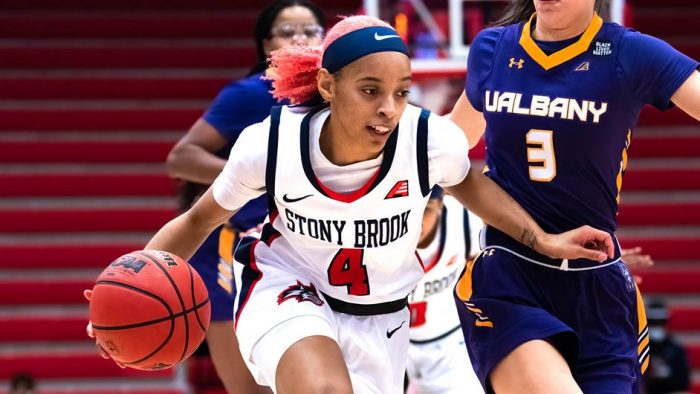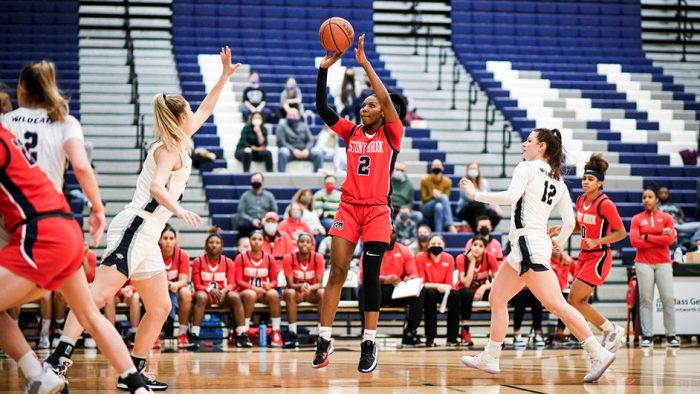Stony Brook University men’s lacrosse head coach Anthony Gilardi has named Mike McCannell, Christian Lowd, Dylan Pallonetti, Michael Sabella, and Wayne White as team captains for the 2022 season.
“We could not be more excited to announce our captains. There is no greater honor on a team than being elected a captain by your teammates. This group is everything Stony Brook lacrosse is all about, they work hard, are tough, and love playing lacrosse. We are excited to see how far we can go with the leadership of these men,” said coach Gilardi.
McCannell recorded 38 points (19 goals, 19 assists) in 2021 and was tabbed to the All-America East First Team. He was tied for fourth in the America East in assists and ranked sixth in the league in assists per game (1.36). The Orangeville, Ontario native scored a season-high five goals in a 22-8 win on April 24, 2021.
Lowd saw action in all 14 games last season and picked up 39 ground balls, which were the second-most on the team. He recorded 10 caused turnovers and scored his first career goal at UMass Lowell on March 20.
Pallonetti was the league’s Offensive Player of the Year and Rookie of the Year in 2021. He became the first student-athlete in America East history to win the Player of the Year and Rookie of the Year honors in the same season. Pallonetti recorded 55 points (36 goals, 19 assists) in his first season on Long Island. He ranked second in the America East in goals, second in points per game (3.93), and tied for fourth in assists per game.
Sabella had a standout season in 2021 as he was named to the All-America East First Team, America East All-Rookie Team, and America East All-Championship Team. He picked up 23 ground balls and registered 14 caused turnovers.
White appeared in 12 games, recorded eight points, which included three goals and five assists, and picked up nine ground balls. White scored the tie-breaking goal with 6:55 remaining in the third quarter to help lead the Seawolves to a 14-8 win over Bryant on February 20, 2021.
——————————
Stony Brook is slated to play a total of 14 games, seven of which will take place at LaValle Stadium and it is set to host 2021 NCAA Tournament teams Rutgers, Syracuse, and Vermont.
“We are excited to announce our 2022 schedule. We have a very challenging non-conference slate that is designed to prepare us for a tough conference schedule. We are looking forward to the Long Island Cup event hosted at Hofstra this year. It is going to be a great event to highlight Long Island lacrosse as well as great preparation for the America East Tournament,” said coach Gilardi. “With the return of fans to LaValle Stadium, we are looking forward to big home crowds as we have one of the best home slates in recent years highlighted by 2021 NCAA Tournament teams Rutgers, Syracuse, and Vermont.”
The Seawolves begin the 2022 campaign with a pair of home games at LaValle Stadium. Stony Brook first welcomes Fairfield to Long Island on February 12, followed by a meeting with Robert Morris on February 19.
After playing two home games to get the season started, Stony Brook takes part in the LI Cup being hosted by Hofstra on February 25, and February 27. The Seawolves go head-to-head with New York foe St. John’s on February 25, and their opponent on February 27, will be determined following the opening round of the tournament.
Stony Brook returns home to host perennial NCAA Tournament contender Rutgers out of the Big Ten. The Scarlet Knights advanced to the NCAA Tournament quarterfinals in 2021, where they fell to No. 1 North Carolina, 12-11, in overtime. The Seawolves are 6-6 all-time against Rutgers and it will be the first time that they host the Scarlet Knights since March 11, 2016, when they picked up a 15-6 win.
Following the meeting with Rutgers, Stony Brook travels to Providence, R.I. to face Brown on March 12. The Seawolves are back on Long Island for back-to-back home games, first against UMass Lowell in the America East opener on March 16.
The Seawolves then welcome national power Syracuse to LaValle Stadium on March 19. It will mark the second time in history that the teams play each other and the first time that they square off on Long Island. Stony Brook fell to Syracuse last season in the first-ever meeting between the teams at the Carrier Dome. The Orange advanced to the NCAA Tournament last season, where they fell to Georgetown in the opening round.
After the two-game homestand, the Seawolves play four out of their final six games of the regular season on the road. Stony Brook heads to UAlbany on March 26, and then travels to play at Dartmouth on April 5. The Seawolves are back home to play host to NJIT on April 9.
Stony Brook travels to play at Binghamton on Friday, April 16, and at UMBC on April 23. The 2022 regular season finale is a rematch of the 2021 America East semifinals between Stony Brook and Vermont on April 30. Vermont went on to win the America East Tournament and earn the league’s automatic qualifier into the NCAA Tournament where it fell to Maryland in the opening round.
The 2022 America East men’s lacrosse tournament is set to take place from May 5-7, and will be hosted by the tournament No. 1 overall seed. The top four teams from the regular season will advance to the conference tournament.
The Seawolves return All-Conference selections Dylan Pallonetti, Mike McCannell, Michael Sabella, David Estrella, and Austin Deskewicz to their 2022 roster. In addition to being an All-America East First Team and All-Rookie selection, Pallonetti was the league’s Offensive Player of the Year and Rookie of the Year. He became the first student-athlete in America East history to win the Player of the Year and Rookie of the Year honors in the same season.






 Under the artistic direction of dance Icons Dwight Rhoden and Desmond Richardson, (both former principal dancers with ALVIN AILEY DANCE and star choreographers), COMPLEXIONS will perform two monumental pieces, “WOKE” and LOVE ROCKS”, born out of the current crisis’ we are facing in the world. Through dance, COMPLEXIONS confronts this moment in time and the question of what it means to exist in today’s society and how we connect in spite of it.
Under the artistic direction of dance Icons Dwight Rhoden and Desmond Richardson, (both former principal dancers with ALVIN AILEY DANCE and star choreographers), COMPLEXIONS will perform two monumental pieces, “WOKE” and LOVE ROCKS”, born out of the current crisis’ we are facing in the world. Through dance, COMPLEXIONS confronts this moment in time and the question of what it means to exist in today’s society and how we connect in spite of it.








